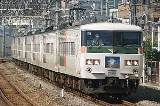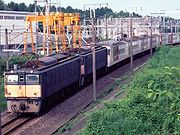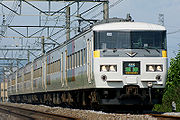
185 series
Encyclopedia
The is an EMU
operated by East Japan Railway Company
(JR East) primarily on middle-distance limited express
services centering on Tokyo
.
The class is broadly divided into two variants: 185-0 series for use south-west of Tokyo, and 185-200 series originally for use north of Tokyo.
. The requirement was also for a "general-purpose" train that could also be used occasionally on local services. This resulted in a design featuring 1,000 mm wide doors at either end of each car, compared with the standard limited express (e.g. 183 series
) layout with 700 mm wide doors at one end of each car.
A total of eight 10-car sets (sets A1 to A8, including two Green cars) and seven 5-car sets (sets C1 to C7) were built between 1979 and 1980 (115 vehicles in total), delivered to Tamachi depot. Initially, they were phased in on Izu express trains from March 1981, working alongside (and sometimes coupled with) the older 153 series trains. In October 1981, the Izu express was upgraded to become the Odoriko
limited express, with all trains formed of 185 series sets.
In addition to the Odoriko services, sets are used on morning and evening "Liner" commuter services, including the Shōnan Liner. Since the start of the October 1981 timetable, 185 series sets have also been used on the 521M local service from Tokyo (depart 07:24) to Izu (arrive 09:48).
 Source:
Source:
Cars 3, 7, and 9 each have one pantograph.
Car 14 is equipped with a pantograph.

 Sixteen 7-car sets (112 vehicles) including one Green car were delivered between 1980 and 1981 to Shin-Maebashi depot to replace ageing 165 series EMUs. Compared with the earlier 185-0 series sets, these had cold-region specifications, including snow-resistant brakes, front-end horn covers, and were able to operate over the Usui Pass
Sixteen 7-car sets (112 vehicles) including one Green car were delivered between 1980 and 1981 to Shin-Maebashi depot to replace ageing 165 series EMUs. Compared with the earlier 185-0 series sets, these had cold-region specifications, including snow-resistant brakes, front-end horn covers, and were able to operate over the Usui Pass
between Yokokawa and Karuizawa in conjunction with JNR Class EF63
electric locomotives. Livery was white with a single green band running the length of each car below the windows. The first trains were introduced on express services such as the Kusatsu
and Karuizawa from December 1981.
Currently, the Ōmiya-based sets are used on Kusatsu (Ueno - Manza-Kazawaguchi), Minakami
(Ueno - Minakami), and Akagi
(Ueno - Maebashi) limited express services, as well as Weekend Akagi services. The Tamachi-based B sets are used on Ohayō Tochigi (Shinjuku - Kuroiso/Utsunomiya) and Hometown Tochigi (Shinjuku - Kuroiso) services as well as Odoriko and Hamakaiji
limited express services.
Cars 2 and 4 each have one pantograph.
Cars 3 and 6 each have one pantograph.
shuttle services operating between Ueno
in Tokyo and Ōmiya
, the then southern terminus of the newly-opened Tōhoku Shinkansen
. These services ended in March 1985 when the shinkansen line was extended to Ueno. Four sets were then transferred to Tamachi depot for use on Odoriko services. These sets were reformed with the Green car moved from car 6 to car 4, and were repainted with diagonal green stripes to match the 185-0 series sets based at Tamachi depot. A further three sets were transferred to Tamachi between 1988 and 1991, becoming sets B1 to B7.
 Between 1993 and 1998, the original Japanese-style toilets in cars 1, 4, and 7 of the Tamachi-based B sets were replaced with western-style toilets.
Between 1993 and 1998, the original Japanese-style toilets in cars 1, 4, and 7 of the Tamachi-based B sets were replaced with western-style toilets.
The nine sets remaining at Shin-Maebashi depot were all refurbished between September 1995 and November 1996. Refurbishment involved replacing the original flip-over seating in standard-class cars with rotating/reclining seats. Externally, the sets were repainted in white with yellow/grey/red blocks intended to depict the Jōmō mountain range together with "EXPRESS 185" markings below the windows.
In March 2006, the Shin-Maebashi-based sets were transferred to Ōmiya depot, becoming sets OM01 to OM09.
Between March and June 1996, three of the 7-car sets based at Tamachi (B3 to B5) were fitted with ATC equipment for use on the Keihin-Tōhoku Line
and Negishi Line
when operating on Hamakaiji services. These sets were upgraded with D-ATC equipment between January 2006 and March 2007.
limited express service scheduled for October.
Multiple unit
The term multiple unit or MU is used to describe a self-propelled carriages capable of coupling with other units of the same or similar type and still being controlled from one driving cab. The term is commonly used to denote passenger trainsets consisting of more than one carriage...
operated by East Japan Railway Company
East Japan Railway Company
is the largest passenger railway company in the world and one of the seven Japan Railways Group companies. The company name is officially abbreviated as JR East in English, and as in Japanese. The company's headquarters are in Yoyogi, Shibuya, Tokyo....
(JR East) primarily on middle-distance limited express
Limited express
A limited express is a type of express train service. It refers to an express service that stops at a limited number of stops in comparison to other express services on the same or similar routes.- Japan :...
services centering on Tokyo
Tokyo
, ; officially , is one of the 47 prefectures of Japan. Tokyo is the capital of Japan, the center of the Greater Tokyo Area, and the largest metropolitan area of Japan. It is the seat of the Japanese government and the Imperial Palace, and the home of the Japanese Imperial Family...
.
The class is broadly divided into two variants: 185-0 series for use south-west of Tokyo, and 185-200 series originally for use north of Tokyo.
185-0 series
The 185 series was primarily intended to replace ageing 153 series EMUs used on Izu express trains from Tokyo to the Izu PeninsulaIzu Peninsula
The is a large mountainous peninsula with deeply indented coasts to the west of Tokyo on the Pacific coast of the island of Honshū, Japan. Formerly the eponymous Izu Province, Izu peninsula is now a part of Shizuoka Prefecture...
. The requirement was also for a "general-purpose" train that could also be used occasionally on local services. This resulted in a design featuring 1,000 mm wide doors at either end of each car, compared with the standard limited express (e.g. 183 series
183 series
The is a limited express EMU introduced in 1972 by Japanese National Railways , and currently operated by East Japan Railway Company and West Japan Railway Company...
) layout with 700 mm wide doors at one end of each car.
A total of eight 10-car sets (sets A1 to A8, including two Green cars) and seven 5-car sets (sets C1 to C7) were built between 1979 and 1980 (115 vehicles in total), delivered to Tamachi depot. Initially, they were phased in on Izu express trains from March 1981, working alongside (and sometimes coupled with) the older 153 series trains. In October 1981, the Izu express was upgraded to become the Odoriko
Odoriko
The is a limited express train service in Japan operated by East Japan Railway Company , which runs between Tokyo and or in Shizuoka Prefecture.-Operations:...
limited express, with all trains formed of 185 series sets.
In addition to the Odoriko services, sets are used on morning and evening "Liner" commuter services, including the Shōnan Liner. Since the start of the October 1981 timetable, 185 series sets have also been used on the 521M local service from Tokyo (depart 07:24) to Izu (arrive 09:48).
Formations

10-car Tamachi sets A1 to A8
| Car No. | 1 | 2 | 3 | 4 | 5 | 6 | 7 | 8 | 9 | 10 |
|---|---|---|---|---|---|---|---|---|---|---|
| Numbering | KuHa 185 | MoHa 184 | MoHa 185 | SaRo 185 | SaRo 185 | MoHa 184 | MoHa 185 | MoHa 184 | MoHa 185 | KuHa 185-100 |
Cars 3, 7, and 9 each have one pantograph.
5-car Tamachi sets C1 to C7
| Car No. | 11 | 12 | 13 | 14 | 15 |
|---|---|---|---|---|---|
| Numbering | KuHa 185 | SaHa 185 | MoHa 184 | MoHa 185 | KuHa 185-100 |
Car 14 is equipped with a pantograph.
Refurbishment
Between 1993 and 1998, the original Japanese-style toilets in cars 1, 5, and 10 of the A sets, and cars 11 and 15 of the C sets were replaced with western-style toilets. In 1998, the Green car seats were upgraded. Then, from 1999 to 2002, all sets underwent refurbishment, which primarily involved replacing the original flip-over seating in standard-class cars with rotating/reclining seats to bring the level of accommodation in line with other limited express rolling stock. Externally, the sets were repainted from the original white livery with diagonal green stripes to white with "Shōnan" green and orange blocks.185-200 series


Usui Pass
The is a mountain pass that lies between Nagano and Gunma Prefectures in Japan. It has served as one of the major transportation routes in central Japan since at least the eighth century.- Road :...
between Yokokawa and Karuizawa in conjunction with JNR Class EF63
JNR Class EF63
The JNR Class EF63 is a class of 1,500 V DC electric locomotives formerly operating in Japan.-History:A total of 25 Class EF63 locomotives were built between 1962 and 1976 exclusively for use as bankers on the steeply-graded Usui Pass section of the Shinetsu Main Line between Yokokawa and Karuizawa...
electric locomotives. Livery was white with a single green band running the length of each car below the windows. The first trains were introduced on express services such as the Kusatsu
Kusatsu (train)
The is a limited express train service in Japan operated by JR East which runs between Ueno in Tokyo and Manza-Kazawaguchi.-History:The Kusatsu service began on 1 June 1960 as a semi express between Ueno and Naganohara The is a limited express train service in Japan operated by JR East which runs...
and Karuizawa from December 1981.
Currently, the Ōmiya-based sets are used on Kusatsu (Ueno - Manza-Kazawaguchi), Minakami
Minakami (train)
The is a limited express train service in Japan operated by the East Japan Railway Company between Ueno in Tokyo and Minakami in Gunma Prefecture.-History:...
(Ueno - Minakami), and Akagi
Akagi (train)
The is a limited express train service in Japan operated by JR East which runs between Ueno and Shin-Maebashi.-External links:*...
(Ueno - Maebashi) limited express services, as well as Weekend Akagi services. The Tamachi-based B sets are used on Ohayō Tochigi (Shinjuku - Kuroiso/Utsunomiya) and Hometown Tochigi (Shinjuku - Kuroiso) services as well as Odoriko and Hamakaiji
Kaiji (train)
The is a limited express train service in Japan operated by East Japan Railway Company . It runs mainly between Shinjuku Station in Tokyo and Kōfu Station in Kōfu, Yamanashi via the Chūō Main Line.-Kaiji:Shinjuku - Kōfu...
limited express services.
7-car Ōmiya sets OM01 to OM09
| Car No. | 1 | 2 | 3 | 4 | 5 | 6 | 7 |
|---|---|---|---|---|---|---|---|
| Numbering | KuHa 185-300 | MoHa 185-200 | MoHa 184-200 | MoHa 185-200 | MoHa 184-200 | SaRo 185-200 | KuHa 185-200 |
Cars 2 and 4 each have one pantograph.
7-car Tamachi sets B1 to B7
| Car No. | 1 | 2 | 3 | 4 | 5 | 6 | 7 |
|---|---|---|---|---|---|---|---|
| Numbering | KuHa 185-200 | MoHa 184-200 | MoHa 185-200 | SaRo 185-200 | MoHa 184-200 | MoHa 185-200 | KuHa 185-300 |
Cars 3 and 6 each have one pantograph.
Shinkansen Relay
Between 23 June 1982 and March 1985, the 185-200 series trains were also used on special Shinkansen RelayShinkansen Relay
is the name of a train service operated by Japan National Railways in Japan between 1982 and 1985.When the Tōhoku Shinkansen was opened in June 1982, the planned section between Ueno in Tokyo and Ōmiya was not complete, with shinkansen services starting and terminating at Ōmiya Station...
shuttle services operating between Ueno
Ueno Station
is a major railway station inTokyo's Taitō ward. It is the station used to reach the Ueno district and Ueno Park -- which contains Tokyo National Museum, The National Museum of Western Art, Ueno Zoo, Tokyo National University of Fine Arts and Music and other famous cultural facilities...
in Tokyo and Ōmiya
Omiya Station (Saitama)
is a railway station in Ōmiya-ku, Saitama, Japan. It is a major interchange station for the East Japan Railway Company .-JR East:* Tōhoku Shinkansen* Akita Shinkansen* Yamagata Shinkansen* Jōetsu Shinkansen* Nagano Shinkansen...
, the then southern terminus of the newly-opened Tōhoku Shinkansen
Tohoku Shinkansen
The is a Japanese high-speed Shinkansen rail line, connecting Tokyo with Aomori in Aomori Prefecture for a total length of 674 km, Japan's longest Shinkansen line. It runs through the more sparsely populated Tōhoku region of Japan's main island Honshu. It has two spur lines, Yamagata...
. These services ended in March 1985 when the shinkansen line was extended to Ueno. Four sets were then transferred to Tamachi depot for use on Odoriko services. These sets were reformed with the Green car moved from car 6 to car 4, and were repainted with diagonal green stripes to match the 185-0 series sets based at Tamachi depot. A further three sets were transferred to Tamachi between 1988 and 1991, becoming sets B1 to B7.
Refurbishment

The nine sets remaining at Shin-Maebashi depot were all refurbished between September 1995 and November 1996. Refurbishment involved replacing the original flip-over seating in standard-class cars with rotating/reclining seats. Externally, the sets were repainted in white with yellow/grey/red blocks intended to depict the Jōmō mountain range together with "EXPRESS 185" markings below the windows.
In March 2006, the Shin-Maebashi-based sets were transferred to Ōmiya depot, becoming sets OM01 to OM09.
Between March and June 1996, three of the 7-car sets based at Tamachi (B3 to B5) were fitted with ATC equipment for use on the Keihin-Tōhoku Line
Keihin-Tohoku Line
The , is a railway line in Japan which connects the cities of Saitama, Kawaguchi, Tokyo, Kawasaki, and Yokohama. It is part of the East Japan Railway Company network. The line's name is derived from the characters for , and the...
and Negishi Line
Negishi Line
The is a Japanese railway line which runs between Yokohama and Ōfuna stations. It is operated by East Japan Railway Company . Freight trains also run on this line, and it is essential for the southern Keihin region....
when operating on Hamakaiji services. These sets were upgraded with D-ATC equipment between January 2006 and March 2007.
Kusatsu 50th anniversary
In September 2010, 7-car set OM03 was repainted into the Shōnan colour scheme of orange and green (never previously carried by this type) to recreate the appearance of the early 80 series EMUs, as part of the 50th anniversary celebrations of the KusatsuKusatsu (train)
The is a limited express train service in Japan operated by JR East which runs between Ueno in Tokyo and Manza-Kazawaguchi.-History:The Kusatsu service began on 1 June 1960 as a semi express between Ueno and Naganohara The is a limited express train service in Japan operated by JR East which runs...
limited express service scheduled for October.

